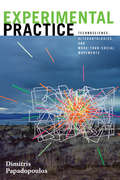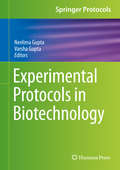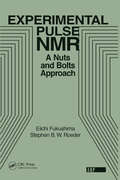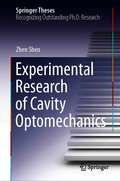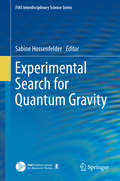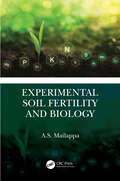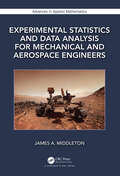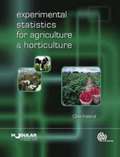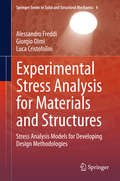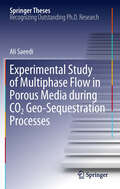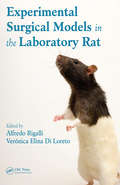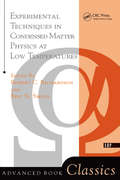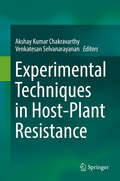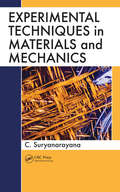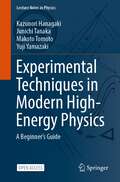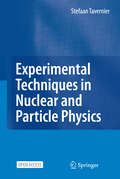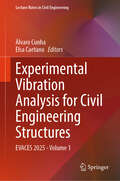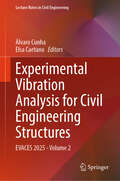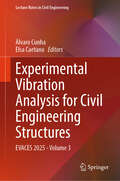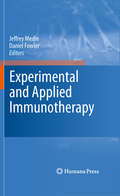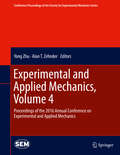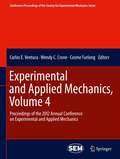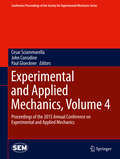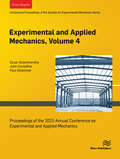- Table View
- List View
Experimental Practice: Technoscience, Alterontologies, and More-Than-Social Movements (Experimental Futures)
by Dimitris PapadopoulosIn Experimental Practice Dimitris Papadopoulos explores the potential for building new forms of political and social movements through the reconfiguration of the material conditions of existence. <P><P>Rather than targeting existing institutions in demands for social justice, Papadopoulos calls for the creation of alternative ontologies of everyday life that would transform the meanings of politics and justice. Inextricably linked to technoscience, these “alterontologies”—which Papadopoulos examines in a variety of contexts, from AIDS activism and the financialization of life to hacker communities and neuroscience—form the basis of ways of life that would embrace the more-than-social interdependence of the human and nonhuman worlds. <P><P>Speaking to a matrix of concerns about politics and justice, social movements, matter and ontology, everyday practice, technoscience, the production of knowledge, and the human and nonhuman, Papadopoulos suggests that the development of alterontologies would create more efficacious political and social organizing.
Experimental Protocols in Biotechnology (Springer Protocols Handbooks)
by Varsha Gupta Neelima GuptaThis manual provides insights into the theory and practical aspects of several biotechnological and biochemical techniques for plants, protozoa, nematodes, insects and fishes, as well as human samples. The book also covers bioinformatics tools. The manual is an inclusive compilation, explaining techniques for microbial cultures, their diagnostics, DNA barcoding, microscopic techniques, blood analysis, parasite diagnostics through copro-antigens, enzyme analysis with enzyme kinetics, gene expression analysis, in-vivo protein visualization in live animals, geno-toxicity assays, quantification of micro RNAs and LncRNAs in tissue sections, the use of droplet PCR, and in-silico analysis. It provides step-by-step descriptions and details of each methodology, together with the final outcomes and inferences, in a simple and lucid manner, easily reproducible even for beginners. The broad range of techniques covered makes this volume extremely useful in understanding the principles of biotechniques, and simple applications for practical courses.
Experimental Pulse NMR: A Nuts and Bolts Approach
by Eiichi FukushimaThis book is about pulse nuclear magnetic resonance (NMR), with its techniques, the information to be obtained, and practical advice on performing experiments. The emphasis is on the motivation and physical ideas underlying NMR experiments and the actual techniques, including the hardware used. The level is generally suitable for those to whom pulse NMR is a new technique, be they students in chemistry or physics on the one hand and research workers in biology, geology, or agriculture, on the other. The book can be used for a senior or first year graduate course where it could supplement the standard NMR texts.
Experimental Research of Cavity Optomechanics (Springer Theses)
by Zhen ShenThis thesis presents experimental research on the interaction between the optical field and the mechanical oscillator in whispering-gallery mode microcavities. It demonstrates how optomechanical interactions in a microresonator can be used to achieve non-magnetic non-reciprocity and develop all-optically controlled non-reciprocal multifunctional photonic devices. The thesis also discusses the interaction between the travelling optical and mechanical whispering-gallery modes, paving the way for non-reciprocal light storage as a coherent, circulating acoustic wave with a lifetime of up to tens of microseconds. Lastly, the thesis presents a high-frequency phase-sensitive heterodyne vibrometer, operating up to 10 GHz, which can be used for the high-resolution, non-invasive mapping of the vibration patterns of acoustic devices. The results presented here show that optomechanical devices hold great potential in the field of information processing.
Experimental Search for Quantum Gravity
by Sabine HossenfelderThis book summarizes recent developments in the research area of quantum gravity phenomenology. A series of short and nontechnical essays lays out the prospects of various experimental possibilities and their current status. Finding observational evidence for the quantization of space-time was long thought impossible. In the last decade however, new experimental design and technological advances have changed the research landscape and opened new perspectives on quantum gravity. Formerly dominated by purely theoretical constructions, quantum gravity now has a lively phenomenology to offer. From high precision measurements using macroscopic quantum oscillators to new analysis methods of the cosmic microwave background, no stone is being left unturned in the experimental search for quantum gravity. This book sheds new light on the connection of astroparticle physics with the quantum gravity problem. Gravitational waves and their detection are covered. It illustrates findings from the interconnection between general relativity, black holes and Planck stars. Finally, the return on investment in quantum-gravitation research is illuminated. The book is intended for graduate students and researchers entering the field.
Experimental Soil Fertility and Biology
by A.S. MailappaSoil fertility and plant nutrition is an applied science that integrates knowledge across all disciplines of soil and plant sciences to provide nutrients effectively and efficiently to plants. Efficient use of nutrients is required not only to maximize agricultural production but also to protect air, soil, and water quality as well as the natural resources involved in providing fertilizers to support agricultural production. This book, Experimental Soil Biology and Fertility, by Dr. A. S. Mailappa, is truly a tour de force of condensation of the essentials of scientific knowledge and approaches to soil science and discusses the various aspects of soil fertility and crop nutrition with a focus on collection, preparation, and analysis of essential plant nutrients in soil, plant, and water. This book is unique, written in a simple and lucid manner and covering all aspects of soil fertility and biology in comprehensive chapters. This book is organized to facilitate rapid location of information, while being written in a readable style. The topics and discussion in this self-contained book are practical and user-friendly, yet comprehensive enough to cover material presented in upper-level soil and plant science courses. It allows practitioners with general background knowledge to feel confident applying the principles presented to soil/crop production systems. Readership: students / teachers / researchers / practitioners of agricultural universities/ institutes, engaged in teaching, research and extension activities related to agriculture, horticulture, forestry, and other allied disciplines.
Experimental Statistics and Data Analysis for Mechanical and Aerospace Engineers (Advances in Applied Mathematics)
by James A. MiddletonThis book develops foundational concepts in probability and statistics with primary applications in mechanical and aerospace engineering. It develops the mindset a data analyst must have to interpret an ill-defined problem, operationalize it, collect or interpret data, and use this evidence to make decisions that can improve the quality of engineered products and systems. It was designed utilizing the latest research in statistics learning and in engagement teaching practices The author’s focus is on developing students’ conceptual understanding of statistical theory with the goal of effective design and conduct of experiments. Engineering statistics is primarily a form of data modeling. Emphasis is placed on modelling variation in observations, characterizing its distribution, and making inferences with regards to quality assurance and control. Fitting multivariate models, experimental design and hypothesis testing are all critical skills developed. All topics are developed utilizing real data from engineering projects, simulations, and laboratory experiences. In other words, we begin with data, we end with models. The key features are: Realistic contexts situating the learning of the statistics in actual engineering practice. A balance of rigorous mathematics, conceptual scaffolding, and real, messy data, to ensure that students learn the important concepts and can apply them in practice. The consistency of text, lecture notes, data sets, and simulations yield a coherent set of instructional resources for the instructor and a coherent set of learning experiences for the students. MatLab is used as a computational tool. Other tools are easily substituted. Table of Contents 1. Introduction2. Dealing with Variation3. Types of Data4. Introduction to Probability5. Sampling Distribution of the Mean6. The Ten Building Blocks of Experimental Design7. Sampling Distribution of the Proportion8. Hypothesis Testing Using the 1-sample Statistics9. 2-sample Statistics10. Simple Linear Regression11. The General Linear Model: Regression with Multiple Predictors12. The GLM with Categorical Independent Variables: The Analysis of Variance13. The General Linear Model: Randomized Block Factorial ANOVA14. Factorial Analysis of Variance15. The Bootstrap16. Data Reduction: Principal Components AnalysisIndex Author Biography James A. Middleton is Professor of Mechanical and Aerospace Engineering and former Director of the Center for Research on Education in Science, Mathematics, Engineering, and Technology at Arizona State University. Previously, he held the Elmhurst Energy Chair in STEM education at the University of Birmingham in the UK. He received his Ph.D. from the University of Wisconsin-Madison. He has been Senior co-Chair of the Special Interest Group for Mathematics Education in the American Educational Research Association, and as Chair of the National Council of Teachers of Mathematics’ Research Committee. He has been a consultant for the College Board, the Rand Corporation, the National Academies, the American Statistical Association, the IEEE, and numerous school systems around the United States, the UK, and Australia. He has garnered over $30 million in grants to study and improve mathematics education in urban schools.
Experimental Statistics for Agriculture and Horticulture
by Clive IrelandProviding practical training supported by a sound theoretical basis, this textbook introduces students to the principles of investigation by experiment and the role of statistics in analysis. It draws on the author's extensive teaching experience and is illustrated with fully worked contextualized examples throughout, helping the reader to correctly design their own experiments and identify the most appropriate technique for analysis. Subjects covered include sampling and determining sample reliability, hypothesis testing, relationships between variables, the role and use of computer packages such as Genstat, and more complex experimental designs such as randomized blocks and split plots.
Experimental Stress Analysis for Materials and Structures
by Alessandro Freddi Giorgio Olmi Luca CristofoliniThis book summarizes the main methods of experimental stress analysis and examines their application to various states of stress of major technical interest, highlighting aspects not always covered in the classic literature. It is explained how experimental stress analysis assists in the verification and completion of analytical and numerical models, the development of phenomenological theories, the measurement and control of system parameters under operating conditions, and identification of causes of failure or malfunction. Cases addressed include measurement of the state of stress in models, measurement of actual loads on structures, verification of stress states in circumstances of complex numerical modeling, assessment of stress-related material damage, and reliability analysis of artifacts (e. g. prostheses) that interact with biological systems. The book will serve graduate students and professionals as a valuable tool for finding solutions when analytical solutions do not exist.
Experimental Study of Multiphase Flow in Porous Media during CO2 Geo-Sequestration Processes
by Ali SaeediThere have been numerous computer-based simulation studies carried out on the subject of CO2 geo-sequestration. However, the amount of experimental data available in the literature on this topic, especially with regards to multiphase flow characteristics of fluid-rock systems during such processes, is very limited. This research was carried out with the aim of providing a better understanding of the multiphase fluid flow characteristics of fluid-rock systems during the geo-sequestration process. The ultimate goal of this research was to experimentally evaluate the change in a number of multiphase flow characteristics of the system over time caused by the potential chemical and physical/mechanical processes occurring during deep CO2 disposal. In order to achieve this goal the effects of cyclic/alternating CO2-brine flooding, flow direction, existence of residual hydrocarbon (natural gas) and change in the reservoir stress field on the system's multiphase flow behaviour were investigated. Until completion of this study there were no experimental data published in the literature addressing the above mentioned issues and the results obtained, and published within this thesis were the first of their kind.
Experimental Surgical Models in the Laboratory Rat
by Alfredo Rigalli Verónica Elina Di LoretoAn All-Inclusive Guide to Surgical Techniques on RatsThe design of an adequate surgical model, like the choice of the animal model itself, is extremely important for obtaining reliable valuable data. Experimental Surgical Models in the Laboratory Rat summarizes a series of techniques that were applied in the Bone Biology Laboratories, School of Medicine, Rosario National University, Argentina. Stopping just short of an exhaustive analysis of the techniques, this manual describes the basics of each surgical technique, the necessary materials, precautions to consider, the methodology to apply, and the possible results to be obtained in similar experiments.CD-ROM: 250 Illustrations of Surgery Techniques with Step-by-Step InstructionWith succinct descriptions, color photographs, and easy-to-follow steps, the downloadable resources are a practical, full-color roadmap for performing various surgery techniques, such as catheterization, tracheostomy, intramuscular injection, subcutaneous injection, intraperitoneal injection, and oral intubation. This definitive work provides technical and practical data including volumes and concentrations of solutions, catheters used, equipment, and biological variables on the rat. Experimental Surgical Models in the Laboratory Rat is a complete reference for today’s biomedical sciences investigator.
Experimental Techniques In Condensed Matter Physics At Low Temperatures (Advanced Book Program Ser.)
by Robert C. RichardsonThis practical book provides recipes for the construction of devices used in low temperature experimentation. It emphasizes what works, rather than what might be the optimum method, and lists current sources for purchasing components and equipment.
Experimental Techniques in Host-Plant Resistance
by Akshay Kumar Chakravarthy Venkatesan SelvanarayananThe earliest land-plants evolved around 450 million years ago from aquatic plants devoid of vascular systems. The diversification of flowering plants (angiosperms) during the Cretaceous period is associated with speciation in insects. Early insect herbivores were mandibulate, but the evolution of vascular plants led to the co-evolution of other forms of herbivory, such as leaf feeding, sap-sucking, leaf mining, tissue borer, gall forming and nectar-feeding. Plant defense against biotic stress is an adaptive evolution by plants to increase their fitness. Plants use a variety of strategies to defend against damage caused by herbivores. Plant defense mechanisms are either inbuilt or induced. Inbuilt mechanisms are always present within the plant, while induced defenses are produced or mobilized to the site where a plant is injured. Induced defense mechanisms include morphological, physiological changes and production of secondary metabolites.Host plant resistance (HPR) is one of the eco-friendly methods of pest management. It protects the crop by making it less suitable or tolerant to the pest. While books on theoretical aspects of HPR are available, an exclusive book on the practical aspects is lacking. There is a wide gap between the theory and the experimental procedures required for conducting studies on plant resistance for the post graduate students and young researchers. A dire need for a book on practical aspects was strongly felt. Initially a practical manual was prepared which eventually evolved into the present book. We hope this book provides information on major aspects of screening crop germplasm, sampling techniques, genetic and biochemical basis of HPR, behavioural studies on pheromone and plant volatiles, and some of the recent approaches in HPR. Further, the references provide the scientific articles and books as additional information to readers and workers alike.
Experimental Techniques in Materials and Mechanics
by C. SuryanarayanaExperimental Techniques in Materials and Mechanics provides a detailed yet easy-to-follow treatment of various techniques useful for characterizing the structure and mechanical properties of materials. With an emphasis on techniques most commonly used in laboratories, the book enables students to understand practical aspects of the methods and deri
Experimental Techniques in Modern High-Energy Physics: A Beginner‘s Guide (Lecture Notes in Physics #1001)
by Kazunori Hanagaki Junichi Tanaka Makoto Tomoto Yuji YamazakiThis open access book offers a concise overview of how data from large scale experiments are analyzed and how technological tools are used in practice, as in the search for new elementary particles. It focuses on interconnects between physics and detector technology in experimental particle physics, and includes descriptions of mathematical approaches. Readers find all the important steps in analysis, including reconstruction of the momentum and energy of particles from detector information, particle identification, and also the general concept of simulating particle production from collisions and detector responses. As the scale of scientific experiments becomes larger and data-intensive science emerges, the techniques used in the data analysis become ever more complicated, making it difficult for beginners to grasp the overall picture. The book provides an explanation of the idea and concepts behind the methods, helping readers understand journal articles on high energy physics. This book is engaging as it does not overemphasize mathematical formalism and it gives a lively example of how such methods have been applied to the Higgs particle discovery in the Large Hadron Collider (LHC) experiments, which led to Englert and Higgs being awarded the Nobel Prize in Physics for 2013.Graduate students and young researchers can easily obtain the required knowledge on how to start data analyses from these notes, without having to spend time in consulting many experts or digesting huge amounts of literature.
Experimental Techniques in Nuclear and Particle Physics
by Stefaan TavernierThe book is based on a course in nuclear and particle physics that the author has taught over many years to physics students, students in nuclear engineering and students in biomedical engineering. It provides the basic understanding that any student or researcher using such instruments and techniques should have about the subject. After an introduction to the structure of matter at the subatomic scale, it covers the experimental aspects of nuclear and particle physics. Ideally complementing a theoretically-oriented textbook on nuclear physics and/or particle physics, it introduces the reader to the different techniques used in nuclear and particle physics to accelerate particles and to measurement techniques (detectors) in nuclear and particle physics. The main subjects treated are: interactions of subatomic particles in matter; particle accelerators; basics of different types of detectors; and nuclear electronics. The book will be of interest to undergraduates, graduates and researchers in both particle and nuclear physics. For the physicists it is a good introduction to all experimental aspects of nuclear and particle physics. Nuclear engineers will appreciate the nuclear measurement techniques, while biomedical engineers can learn about measuring ionising radiation, the use of accelerators for radiotherapy. What's more, worked examples, end-of-chapter exercises, and appendices with key constants, properties and relationships supplement the textual material.
Experimental Techniques in Nuclear and Particle Physics
by Stefaan TavernierI have been teaching courses on experimental techniques in nuclear and particle physics to master students in physics and in engineering for many years. This book grew out of the lecture notes I made for these students. The physics and engineering students have rather different expectations of what such a course should be like. I hope that I have nevertheless managed to write a book that can satisfy the needs of these different target audiences. The lectures themselves, of course, need to be adapted to the needs of each group of students. An engineering student will not qu- tion a statement like “the velocity of the electrons in atoms is ?1% of the velocity of light”, a physics student will. Regarding units, I have written factors h and c explicitly in all equations throughout the book. For physics students it would be preferable to use the convention that is common in physics and omit these constants in the equations, but that would probably be confusing for the engineering students. Physics students tend to be more interested in theoretical physics courses. However, physics is an experimental science and physics students should und- stand how experiments work, and be able to make experiments work.This is an open access book.
Experimental Vibration Analysis for Civil Engineering Structures: EVACES 2025 - Volume 1 (Lecture Notes in Civil Engineering #674)
by Elsa Caetano Álvaro CunhaThis volume presents peer-reviewed contributions from the 11th International Conference on Experimental Vibration Analysis for Civil Engineering Structures (EVACES), held in Porto, Portugal on July 2-4, 2025. The event brought together engineers, scientists, researchers, and practitioners, providing a forum for discussing and disseminating the latest developments and achievements in all major aspects of dynamic testing for civil engineering structures, including instrumentation, sources of excitation, data analysis, system identification, monitoring and condition assessment, in-situ and laboratory experiments, codes and standards, and vibration mitigation. The topics included but were not limited to: damage identification and structural health monitoring; testing, sensing and modeling; vibration isolation and control; system and model identification; coupled dynamical systems (including human–structure, vehicle–structure, and soil–structureinteraction); and application of advanced techniques involving the Internet of Things, robot, UAV, big data and artificial intelligence.
Experimental Vibration Analysis for Civil Engineering Structures: EVACES 2025 - Volume 2 (Lecture Notes in Civil Engineering #675)
by Elsa Caetano Álvaro CunhaThis volume presents peer-reviewed contributions from the 11th International Conference on Experimental Vibration Analysis for Civil Engineering Structures (EVACES), held in Porto, Portugal on July 2-4, 2025. The event brought together engineers, scientists, researchers, and practitioners, providing a forum for discussing and disseminating the latest developments and achievements in all major aspects of dynamic testing for civil engineering structures, including instrumentation, sources of excitation, data analysis, system identification, monitoring and condition assessment, in-situ and laboratory experiments, codes and standards, and vibration mitigation. The topics included but were not limited to: damage identification and structural health monitoring; testing, sensing and modeling; vibration isolation and control; system and model identification; coupled dynamical systems (including human–structure, vehicle–structure, and soil–structureinteraction); and application of advanced techniques involving the Internet of Things, robot, UAV, big data and artificial intelligence.
Experimental Vibration Analysis for Civil Engineering Structures: EVACES 2025 - Volume 3 (Lecture Notes in Civil Engineering #676)
by Elsa Caetano Álvaro CunhaThis volume presents peer-reviewed contributions from the 11th International Conference on Experimental Vibration Analysis for Civil Engineering Structures (EVACES), held in Porto, Portugal on July 2-4, 2025. The event brought together engineers, scientists, researchers, and practitioners, providing a forum for discussing and disseminating the latest developments and achievements in all major aspects of dynamic testing for civil engineering structures, including instrumentation, sources of excitation, data analysis, system identification, monitoring and condition assessment, in-situ and laboratory experiments, codes and standards, and vibration mitigation. The topics included but were not limited to: damage identification and structural health monitoring; testing, sensing and modeling; vibration isolation and control; system and model identification; coupled dynamical systems (including human–structure, vehicle–structure, and soil–structureinteraction); and application of advanced techniques involving the Internet of Things, robot, UAV, big data and artificial intelligence.
Experimental and Applied Immunotherapy
by Daniel Fowler Jeffrey MedinImmunotherapy is now recognized as an essential component of treatment for a wide variety of cancers. It is an interdisciplinary field that is critically dependent upon an improved understanding of a vast network of cross-regulatory cellular populations and a diversity of molecular effectors; it is a leading example of translational medicine with a favorable concept-to-clinical-trial timeframe of just a few years. There are many established immunotherapies already in existence, but there are exciting new cancer immunotherapies just on the horizon, which are likely to be more potent, less toxic and more cost effective than many therapies currently in use. Experimental and Applied Immunotherapy is a state-of-the-art text offering a roadmap leading to the creation of these future cancer-fighting immunotherapies. It includes essays by leading researchers that cover a wide variety of topics including T cell and non-T cell therapy, monoclonal antibody therapy, dendritic cell-based cancer vaccines, mesenchymal stromal cells, negative regulators in cancer immunology and immunotherapy, non-cellular aspects of cancer immunotherapy, the combining of cancer vaccines with conventional therapies, the combining of oncolytic viruses with cancer immunotherapy, transplantation, and more. The field of immunotherapy holds great promise that will soon come to fruition if creative investigators can bridge seemingly disparate disciplines, such as T cell therapy, gene therapy, and transplantation therapy. This text is a vital tool in the building of that bridge.
Experimental and Applied Mechanics, Volume 4
by Alan T. Zehnder Yong ZhuExperimental and Applied Mechanics, Volume 4 of the Proceedings of the 2016 SEM Annual Conference & Exposition on Experimental and Applied Mechanics, the fourth volume of ten from the Conference, brings together contributions to important areas of research and engineering. The collection presents early findings and case studies on a wide range of topics, including: Hybrid Experimental & Computational Techniques Advanced Experimental Mechanics Methods Integration of Models & Experiments Soft Materials Education & Research in Progress Applications
Experimental and Applied Mechanics, Volume 4
by Wendy C. Crone Carlos E. Ventura Cosme FurlongExperimental and Applied Mechanics, Volume 4: Proceedings of the 2012 Annual Conference on Experimental and Applied Mechanics, the fourth volume of seven from the Conference, brings together 54 contributions to this important area of research and engineering. The collection presents early findings and case studies on fundamental and applied aspects of Experimental and Applied Mechanics, including papers on: Fracture & FatigueMicroscale & Microstructural Effects in Fatigue & FractureMaterial ApplicationsComposite Characterization Using Digital Image Correlation TechniquesMulti-Scale Simulation and Testing of CompositesResidual StressInverse Problems/Hybrid MethodsNano-CompositesMicrostructure Material CharacterizationModeling and Uncertainty QuantificationImpact Behavior of Composites
Experimental and Applied Mechanics, Volume 4
by Cesar Sciammarella John Considine Paul GloecknerExperimental and Applied Mechanics, Volume 4 of the Proceedings of the 2015SEM Annual Conference& Exposition on Experimental and Applied Mechanics, the fourth volume of nine from the Conference, brings together contributions to important areas of research and engineering. The collection presents early findings and case studies on a wide range of topics, including: Advanced Methods for Frontier Applications, Non-Homogeneous Parameters Identification, Teaching Experimental Mechanics in the 21st Century, Material Characterization and Testing, Mechanics of Interfaces Novel Applications of Experimental Mechanics
Experimental and Applied Mechanics, Volume 4: Proceedings of the 2015 Annual Conference on Experimental and Applied Mechanics
by Cesar Sciammarella John Considine Paul GloecknerExperimental and Applied Mechanics, Volume 4 of the Proceedings of the 2015SEM Annual Conference& Exposition on Experimental and Applied Mechanics, the fourth volume of nine from the Conference, brings together contributions to important areas of research and engineering. The collection presents early findings and case studies on a wide range of topics, including: Advanced Methods for Frontier Applications, Non-Homogeneous Parameters Identification, Teaching Experimental Mechanics in the 21st Century, Material Characterization and Testing, Mechanics of Interfaces.
